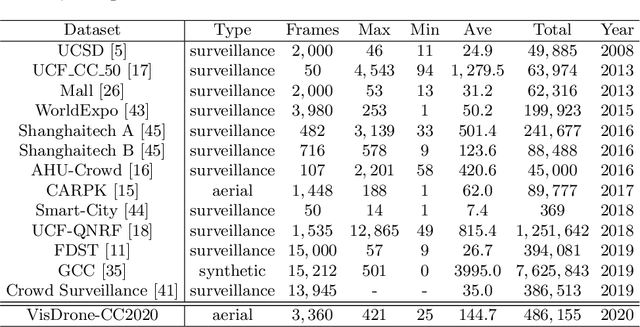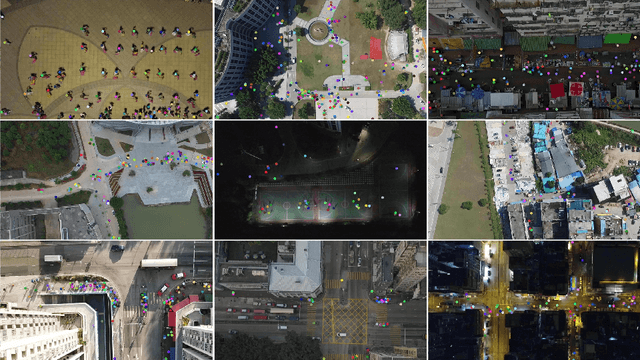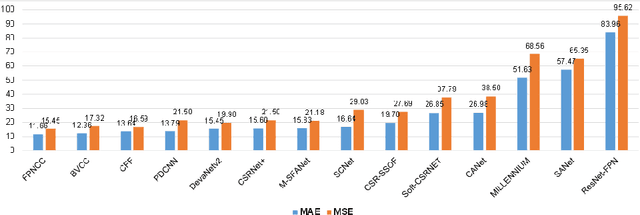Zhiwei Wei
TS-SatMVSNet: Slope Aware Height Estimation for Large-Scale Earth Terrain Multi-view Stereo
Jan 02, 2025



Abstract:3D terrain reconstruction with remote sensing imagery achieves cost-effective and large-scale earth observation and is crucial for safeguarding natural disasters, monitoring ecological changes, and preserving the environment.Recently, learning-based multi-view stereo~(MVS) methods have shown promise in this task. However, these methods simply modify the general learning-based MVS framework for height estimation, which overlooks the terrain characteristics and results in insufficient accuracy. Considering that the Earth's surface generally undulates with no drastic changes and can be measured by slope, integrating slope considerations into MVS frameworks could enhance the accuracy of terrain reconstructions. To this end, we propose an end-to-end slope-aware height estimation network named TS-SatMVSNet for large-scale remote sensing terrain reconstruction.To effectively obtain the slope representation, drawing from mathematical gradient concepts, we innovatively proposed a height-based slope calculation strategy to first calculate a slope map from a height map to measure the terrain undulation. To fully integrate slope information into the MVS pipeline, we separately design two slope-guided modules to enhance reconstruction outcomes at both micro and macro levels. Specifically, at the micro level, we designed a slope-guided interval partition module for refined height estimation using slope values. At the macro level, a height correction module is proposed, using a learnable Gaussian smoothing operator to amend the inaccurate height values. Additionally, to enhance the efficacy of height estimation, we proposed a slope direction loss for implicitly optimizing height estimation results. Extensive experiments on the WHU-TLC dataset and MVS3D dataset show that our proposed method achieves state-of-the-art performance and demonstrates competitive generalization ability.
UniRS: Unifying Multi-temporal Remote Sensing Tasks through Vision Language Models
Dec 30, 2024Abstract:The domain gap between remote sensing imagery and natural images has recently received widespread attention and Vision-Language Models (VLMs) have demonstrated excellent generalization performance in remote sensing multimodal tasks. However, current research is still limited in exploring how remote sensing VLMs handle different types of visual inputs. To bridge this gap, we introduce \textbf{UniRS}, the first vision-language model \textbf{uni}fying multi-temporal \textbf{r}emote \textbf{s}ensing tasks across various types of visual input. UniRS supports single images, dual-time image pairs, and videos as input, enabling comprehensive remote sensing temporal analysis within a unified framework. We adopt a unified visual representation approach, enabling the model to accept various visual inputs. For dual-time image pair tasks, we customize a change extraction module to further enhance the extraction of spatiotemporal features. Additionally, we design a prompt augmentation mechanism tailored to the model's reasoning process, utilizing the prior knowledge of the general-purpose VLM to provide clues for UniRS. To promote multi-task knowledge sharing, the model is jointly fine-tuned on a mixed dataset. Experimental results show that UniRS achieves state-of-the-art performance across diverse tasks, including visual question answering, change captioning, and video scene classification, highlighting its versatility and effectiveness in unifying these multi-temporal remote sensing tasks. Our code and dataset will be released soon.
Towards An Unsupervised Learning Scheme for Efficiently Solving Parameterized Mixed-Integer Programs
Dec 24, 2024Abstract:In this paper, we describe a novel unsupervised learning scheme for accelerating the solution of a family of mixed integer programming (MIP) problems. Distinct substantially from existing learning-to-optimize methods, our proposal seeks to train an autoencoder (AE) for binary variables in an unsupervised learning fashion, using data of optimal solutions to historical instances for a parametric family of MIPs. By a deliberate design of AE architecture and exploitation of its statistical implication, we present a simple and straightforward strategy to construct a class of cutting plane constraints from the decoder parameters of an offline-trained AE. These constraints reliably enclose the optimal binary solutions of new problem instances thanks to the representation strength of the AE. More importantly, their integration into the primal MIP problem leads to a tightened MIP with the reduced feasible region, which can be resolved at decision time using off-the-shelf solvers with much higher efficiency. Our method is applied to a benchmark batch process scheduling problem formulated as a mixed integer linear programming (MILP) problem. Comprehensive results demonstrate that our approach significantly reduces the computational cost of off-the-shelf MILP solvers while retaining a high solution quality. The codes of this work are open-sourced at https://github.com/qushiyuan/AE4BV.
Cloud-Edge-Terminal Collaborative AIGC for Autonomous Driving
Jul 02, 2024



Abstract:In dynamic autonomous driving environment, Artificial Intelligence-Generated Content (AIGC) technology can supplement vehicle perception and decision making by leveraging models' generative and predictive capabilities, and has the potential to enhance motion planning, trajectory prediction and traffic simulation. This article proposes a cloud-edge-terminal collaborative architecture to support AIGC for autonomous driving. By delving into the unique properties of AIGC services, this article initiates the attempts to construct mutually supportive AIGC and network systems for autonomous driving, including communication, storage and computation resource allocation schemes to support AIGC services, and leveraging AIGC to assist system design and resource management.
UAV-VisLoc: A Large-scale Dataset for UAV Visual Localization
May 20, 2024Abstract:The application of unmanned aerial vehicles (UAV) has been widely extended recently. It is crucial to ensure accurate latitude and longitude coordinates for UAVs, especially when the global navigation satellite systems (GNSS) are disrupted and unreliable. Existing visual localization methods achieve autonomous visual localization without error accumulation by matching the ground-down view image of UAV with the ortho satellite maps. However, collecting UAV ground-down view images across diverse locations is costly, leading to a scarcity of large-scale datasets for real-world scenarios. Existing datasets for UAV visual localization are often limited to small geographic areas or are focused only on urban regions with distinct textures. To address this, we define the UAV visual localization task by determining the UAV's real position coordinates on a large-scale satellite map based on the captured ground-down view. In this paper, we present a large-scale dataset, UAV-VisLoc, to facilitate the UAV visual localization task. This dataset comprises images from diverse drones across 11 locations in China, capturing a range of topographical features. The dataset features images from fixed-wing drones and multi-terrain drones, captured at different altitudes and orientations. Our dataset includes 6,742 drone images and 11 satellite maps, with metadata such as latitude, longitude, altitude, and capture date. Our dataset is tailored to support both the training and testing of models by providing a diverse and extensive data.
Deep Semantic-Visual Alignment for Zero-Shot Remote Sensing Image Scene Classification
Feb 03, 2024Abstract:Deep neural networks have achieved promising progress in remote sensing (RS) image classification, for which the training process requires abundant samples for each class. However, it is time-consuming and unrealistic to annotate labels for each RS category, given the fact that the RS target database is increasing dynamically. Zero-shot learning (ZSL) allows for identifying novel classes that are not seen during training, which provides a promising solution for the aforementioned problem. However, previous ZSL models mainly depend on manually-labeled attributes or word embeddings extracted from language models to transfer knowledge from seen classes to novel classes. Besides, pioneer ZSL models use convolutional neural networks pre-trained on ImageNet, which focus on the main objects appearing in each image, neglecting the background context that also matters in RS scene classification. To address the above problems, we propose to collect visually detectable attributes automatically. We predict attributes for each class by depicting the semantic-visual similarity between attributes and images. In this way, the attribute annotation process is accomplished by machine instead of human as in other methods. Moreover, we propose a Deep Semantic-Visual Alignment (DSVA) that take advantage of the self-attention mechanism in the transformer to associate local image regions together, integrating the background context information for prediction. The DSVA model further utilizes the attribute attention maps to focus on the informative image regions that are essential for knowledge transfer in ZSL, and maps the visual images into attribute space to perform ZSL classification. With extensive experiments, we show that our model outperforms other state-of-the-art models by a large margin on a challenging large-scale RS scene classification benchmark.
* Published in ISPRS P&RS. The code is available at https://github.com/wenjiaXu/RS_Scene_ZSL
Jointly Optimized Global-Local Visual Localization of UAVs
Oct 12, 2023



Abstract:Navigation and localization of UAVs present a challenge when global navigation satellite systems (GNSS) are disrupted and unreliable. Traditional techniques, such as simultaneous localization and mapping (SLAM) and visual odometry (VO), exhibit certain limitations in furnishing absolute coordinates and mitigating error accumulation. Existing visual localization methods achieve autonomous visual localization without error accumulation by matching with ortho satellite images. However, doing so cannot guarantee real-time performance due to the complex matching process. To address these challenges, we propose a novel Global-Local Visual Localization (GLVL) network. Our GLVL network is a two-stage visual localization approach, combining a large-scale retrieval module that finds similar regions with the UAV flight scene, and a fine-grained matching module that localizes the precise UAV coordinate, enabling real-time and precise localization. The training process is jointly optimized in an end-to-end manner to further enhance the model capability. Experiments on six UAV flight scenes encompassing both texture-rich and texture-sparse regions demonstrate the ability of our model to achieve the real-time precise localization requirements of UAVs. Particularly, our method achieves a localization error of only 2.39 meters in 0.48 seconds in a village scene with sparse texture features.
ARAI-MVSNet: A multi-view stereo depth estimation network with adaptive depth range and depth interval
Aug 17, 2023Abstract:Multi-View Stereo~(MVS) is a fundamental problem in geometric computer vision which aims to reconstruct a scene using multi-view images with known camera parameters. However, the mainstream approaches represent the scene with a fixed all-pixel depth range and equal depth interval partition, which will result in inadequate utilization of depth planes and imprecise depth estimation. In this paper, we present a novel multi-stage coarse-to-fine framework to achieve adaptive all-pixel depth range and depth interval. We predict a coarse depth map in the first stage, then an Adaptive Depth Range Prediction module is proposed in the second stage to zoom in the scene by leveraging the reference image and the obtained depth map in the first stage and predict a more accurate all-pixel depth range for the following stages. In the third and fourth stages, we propose an Adaptive Depth Interval Adjustment module to achieve adaptive variable interval partition for pixel-wise depth range. The depth interval distribution in this module is normalized by Z-score, which can allocate dense depth hypothesis planes around the potential ground truth depth value and vice versa to achieve more accurate depth estimation. Extensive experiments on four widely used benchmark datasets~(DTU, TnT, BlendedMVS, ETH 3D) demonstrate that our model achieves state-of-the-art performance and yields competitive generalization ability. Particularly, our method achieves the highest Acc and Overall on the DTU dataset, while attaining the highest Recall and $F_{1}$-score on the Tanks and Temples intermediate and advanced dataset. Moreover, our method also achieves the lowest $e_{1}$ and $e_{3}$ on the BlendedMVS dataset and the highest Acc and $F_{1}$-score on the ETH 3D dataset, surpassing all listed methods.Project website: https://github.com/zs670980918/ARAI-MVSNet
Inferring High-level Geographical Concepts via Knowledge Graph and Multi-scale Data Integration: A Case Study of C-shaped Building Pattern Recognition
Apr 19, 2023



Abstract:Effective building pattern recognition is critical for understanding urban form, automating map generalization, and visualizing 3D city models. Most existing studies use object-independent methods based on visual perception rules and proximity graph models to extract patterns. However, because human vision is a part-based system, pattern recognition may require decomposing shapes into parts or grouping them into clusters. Existing methods may not recognize all visually aware patterns, and the proximity graph model can be inefficient. To improve efficiency and effectiveness, we integrate multi-scale data using a knowledge graph, focusing on the recognition of C-shaped building patterns. First, we use a property graph to represent the relationships between buildings within and across different scales involved in C-shaped building pattern recognition. Next, we store this knowledge graph in a graph database and convert the rules for C-shaped pattern recognition and enrichment into query conditions. Finally, we recognize and enrich C-shaped building patterns using rule-based reasoning in the built knowledge graph. We verify the effectiveness of our method using multi-scale data with three levels of detail (LODs) collected from the Gaode Map. Our results show that our method achieves a higher recall rate of 26.4% for LOD1, 20.0% for LOD2, and 9.1% for LOD3 compared to existing approaches. We also achieve recognition efficiency improvements of 0.91, 1.37, and 9.35 times, respectively.
VisDrone-CC2020: The Vision Meets Drone Crowd Counting Challenge Results
Jul 19, 2021



Abstract:Crowd counting on the drone platform is an interesting topic in computer vision, which brings new challenges such as small object inference, background clutter and wide viewpoint. However, there are few algorithms focusing on crowd counting on the drone-captured data due to the lack of comprehensive datasets. To this end, we collect a large-scale dataset and organize the Vision Meets Drone Crowd Counting Challenge (VisDrone-CC2020) in conjunction with the 16th European Conference on Computer Vision (ECCV 2020) to promote the developments in the related fields. The collected dataset is formed by $3,360$ images, including $2,460$ images for training, and $900$ images for testing. Specifically, we manually annotate persons with points in each video frame. There are $14$ algorithms from $15$ institutes submitted to the VisDrone-CC2020 Challenge. We provide a detailed analysis of the evaluation results and conclude the challenge. More information can be found at the website: \url{http://www.aiskyeye.com/}.
* The method description of A7 Mutil-Scale Aware based SFANet (M-SFANet) is updated and missing references are added
 Add to Chrome
Add to Chrome Add to Firefox
Add to Firefox Add to Edge
Add to Edge